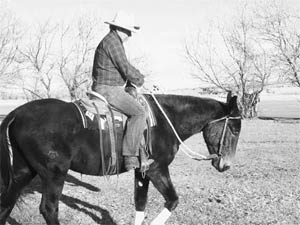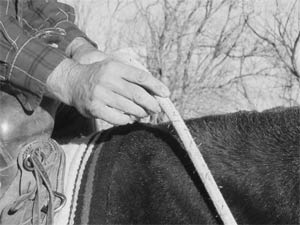We’ve all heard it…..Mules are Hard Mouthed. In some situations this
is true. However, any equine, mules included, can have a very soft
mouth, no matter what the past history of the animal is.
 |
| TIM DOUD
picks up a rein and Diamond Creek Grover responds to TIM’S cue
before he can apply pressure |
Keep in mind….a mule cannot be light if the rider is not light. When
you pick up a rein, how much pressure would you like your mule to
respond to? Fifteen, 10, four, three, two pounds? How about
one-half, one-quarter, or one-eighth of a pound? Is this possible to
take a mule and have him respond to one-eighth of a pound of
pressure, or less? Yes, it is. Every mule can respond to a cue using
one-eighth of a pound of pressure if he is trained to do so.
All of us know of a friend that shakes our hand so hard we think our
fingers will fall off. We see them and say, “Hi”. They quickly grab
our hand and we immediately tense all our muscles in our shoulder,
arm, hand and fingers. Bracing against the pressure we shake their
hand. Our shoulder, arm and hand move as if it weighs a ton. We are
‘Hard Mouthed’.
Walking down the street we see another friend. They slowly extend
their arm and we shake their hand. Our friend shakes our hand, using
very little pressure. Our upper body is almost weightless and moves
with ease because we aren’t anticipating a ‘hard shake’. by slowly
moving his hand towards us our friend gives us time to reach out and
calmly shake.
This is the same with a mule. When we grab a rein quickly and pull
the mule’s head to the side it causes resistance. The mule will
raise his head, stiffen his neck muscles and brace for the pressure
he knows is coming. On the other hand if we slowly pick up a rein
and add one-eighth of a pound of pressure to the bit and hold, we
are giving the mule a chance to respond to one-eighth of a pound of
pressure.
What do you do if you apply the pressure and the mule will not
respond? Increase the pressure to one-quarter of a pound and hold.
Then increase pressure to one-half pound and hold, then one pound
and hold. Remember to increase pressure in small amounts, then hold
the pressure. By holding the pressure we are giving the mule an
opportunity to respond.
When the mule responds correctly to the cue release the rein
completely. A complete release of pressure tells the mule he
responded correctly. What is a correct response? A correct response
is when the mule moves a body part in the direction you are asking.
In this case the mule moves his head towards the pressure of the
rein and you release; hence the correct response.
The slower we go the faster our mule will get there. By going slower
we are giving the mule more time to think about what we are asking
for. But, we must be constant with our cues.
|
 |
|
WITH TRAINING any mule can
respond to rein pressure by using two fingers |
Start by picking up a rein; then slowly add pressure and hold. Next
step is to increase pressure and hold. The mule will learn that when
we pick up a rein we are asking the mule for a response. He will
start looking to respond the moment we pick up the rein in order to
keep pressure off the bit. The mule is learning to respond with less
pressure.
As with any training this will take many repetitions in order for
the mule to respond lightly every time. The mule will need time to
learn to respond to the cue without thinking about it --- your mule
will begin to give you an automatic response.
Your friends will be amazed when you pick up on the rein with two
fingers and your ‘Hard Mouthed’ mule turns his head in the direction
of your light cue.
Tim can be reached at
www.diamondcreekmules.com, or by phone at 307/899-1089, or
email:
bliss@wavecom.net.
|